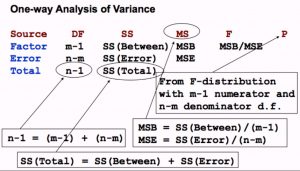

The other rows are used mainly for computational purposes. The row labeled " Between Groups", having a probability value associated with it, is the only one of any great importance at this time. The only column that is critical for interpretation is the last (Sig.)! The others are used mainly for intermediate computational purposes. The results of the ANOVA are presented in an ANOVA table, which has columns labeled Sum of Squares (sometimes referred to as SS), df ( degrees of freedom), Mean Square (sometimes referred to as MS), F (for F-ratio), and Sig. When you check the Descriptive box in the Statistics section of the One-Way ANOVA: Options dialog box (shown in the preceding figure), the result is a table of means and standard deviations, such as the following: The Bottom Line: Results and Interpretation of ANOVA Is decreased when the value of alpha is increased. Is decreased with a greater number of hypothesis tests. Is called the experiment-wise error rate. The probability of committing at least one type I error in an analysis Then select the variables and options, as shown in this figure: Begin the procedure by selecting Statistics/Compare Means/One-Way ANOVA, as the following figure illustrates. In this case, the correct analysis in SPSS is a one-way Analysis of Variance or ANOVA. The ANOVA procedure performs this function. The researcher may want to perform a fewer number of hypothesis tests in order to reduce the experiment-wise error rate. The probability of committing at least one Type I error in an analysis is called the experiment-wise error rate. Second, by doing a greater number of analyses, the probability of committing at least one Type I error somewhere in the analysis greatly increases.

An analysis of variance organizes and directs the analysis, allowing easier interpretation of results. Therein lies the difficulty with multiple t-tests.įirst, because the number of t-tests increases geometrically as a function of the number of groups, analysis becomes cognitively difficult somewhere in the neighborhood of seven different tests. Using this procedure ten different t-tests would be performed. Behavior Therapy is then individually compared with the last three groups, and so on. That is, Reality Therapy is first compared with Behavior Therapy, then Psychoanalysis, then Gestalt Therapy, and then the Control Group.

One method of performing this analysis is by doing all possible t-tests, called multiple t-tests. The researcher wants to compare the means of the groups to decide about the effectiveness of the therapy. The purpose of the study was to determine if one method was more effective than the other methods in improving patients' self-concept.Īt the conclusion of the experiment the researcher creates a data file in SPSS in the following manner:

At the conclusion of the study, changes in self-concept are found for each patient. Twenty patients are randomly assigned to each group. The methods used are Reality Therapy, Behavior Therapy, Psychoanalysis, Gestalt Therapy, and, of course, a control group. Suppose a researcher performs a study on the effectiveness of various methods of individual therapy. Multiple comparisons using t-tests is not the analysis of choice.


 0 kommentar(er)
0 kommentar(er)
